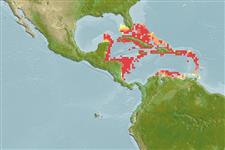Environment: milieu / climate zone / depth range / distribution range
Ecologia
marino associati a barriera corallina; distribuzione batimetrica 5 - 70 m (Ref. 5521). Tropical
Western Central Atlantic: Bahamas and Virgin Islands south to Bonaire and west to Belize.
Size / Peso / Age
Maturity: Lm ? range ? - ? cm
Max length : 6.4 cm TL maschio/sesso non determinato; (Ref. 5521)
Short description
Morfologia | Morfometria
Spine dorsali (totale): 21 - 22; Raggi dorsali molli (totale): 11-13; Spine anali 2; Raggi anali molli: 20 - 23. Upper side has series of dark blotches; lower side has series of diamond-shaped markings (Ref. 26938). Males light brown, finely spotted with white, with an upper row of seven irregular dark-edged brown blotches and a lower row of ten smaller brown blotches of irregular diamond shape with pale centers; females have brownish orange blotches instead of dark brown (Ref. 13442).
Inhabit patch reefs or other deeper water coral formations. Usually associated with Condylactis gigantea (Ref. 9710).
Life cycle and mating behavior
Maturità | Riproduzione | Deposizione | Uova | Fecundity | Larve
Böhlke, J.E. and C.C.G. Chaplin, 1993. Fishes of the Bahamas and adjacent tropical waters. 2nd edition. University of Texas Press, Austin. (Ref. 5521)
IUCN Red List Status (Ref. 130435)
Threat to humans
Harmless
Human uses
Informazioni ulteriori
Nomi ComuniSinonimiMetabolismoPredatoriEcotossicologiaRiproduzioneMaturitàDeposizioneSpawning aggregationFecundityUovaEgg development
Age/SizeAccrescimentoLength-weightLength-lengthLength-frequenciesMorfometriaMorfologiaLarveDinamica popolazioni larvaliReclutamentoAbbondanzaBRUVS
BibliografiaAcquacolturaProfilo di acquacolturaVarietàGeneticaElectrophoresesEreditarietàMalattieElaborazioneNutrientsMass conversion
CollaboratoriImmaginiStamps, Coins Misc.SuoniCiguateraVelocitàModalità di nuotoArea branchialeOtolithsCervelliVista
Strumenti
Special reports
Download XML
Fonti Internet
Estimates based on models
Preferred temperature (Ref.
123201): 25.4 - 28.1, mean 27.6 °C (based on 104 cells).
Phylogenetic diversity index (Ref.
82804): PD
50 = 0.5000 [Uniqueness, from 0.5 = low to 2.0 = high].
Bayesian length-weight: a=0.00912 (0.00399 - 0.02083), b=3.06 (2.87 - 3.25), in cm total length, based on LWR estimates for this (Sub)family-body shape (Ref.
93245).
Trophic level (Ref.
69278): 3.4 ±0.4 se; based on size and trophs of closest relatives
Fishing Vulnerability (Ref.
59153): Low vulnerability (10 of 100).
Nutrients (Ref.
124155): Calcium = 123 [66, 225] mg/100g; Iron = 0.811 [0.479, 1.340] mg/100g; Protein = 18.6 [17.5, 19.7] %; Omega3 = 0.188 [0.109, 0.317] g/100g; Selenium = 23.9 [11.5, 46.7] μg/100g; VitaminA = 228 [73, 695] μg/100g; Zinc = 2.17 [1.46, 3.10] mg/100g (wet weight);
